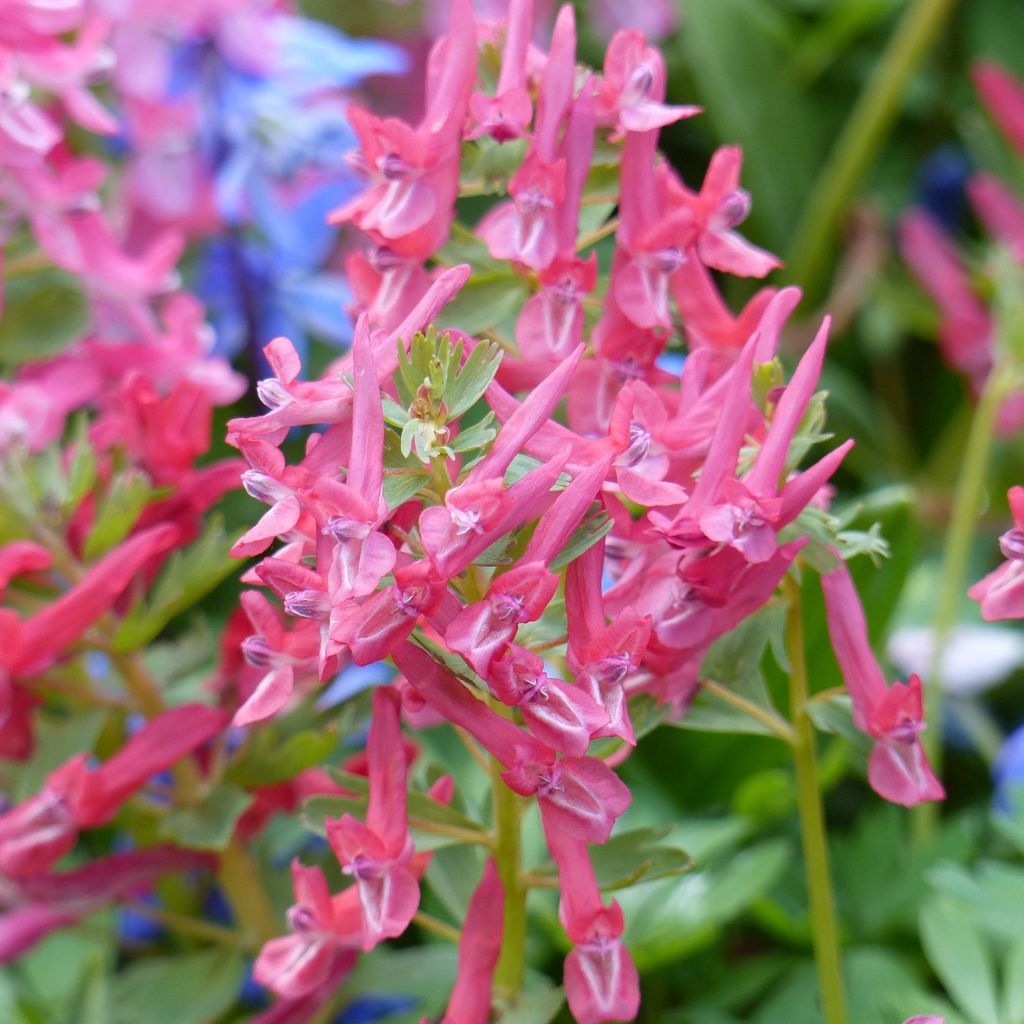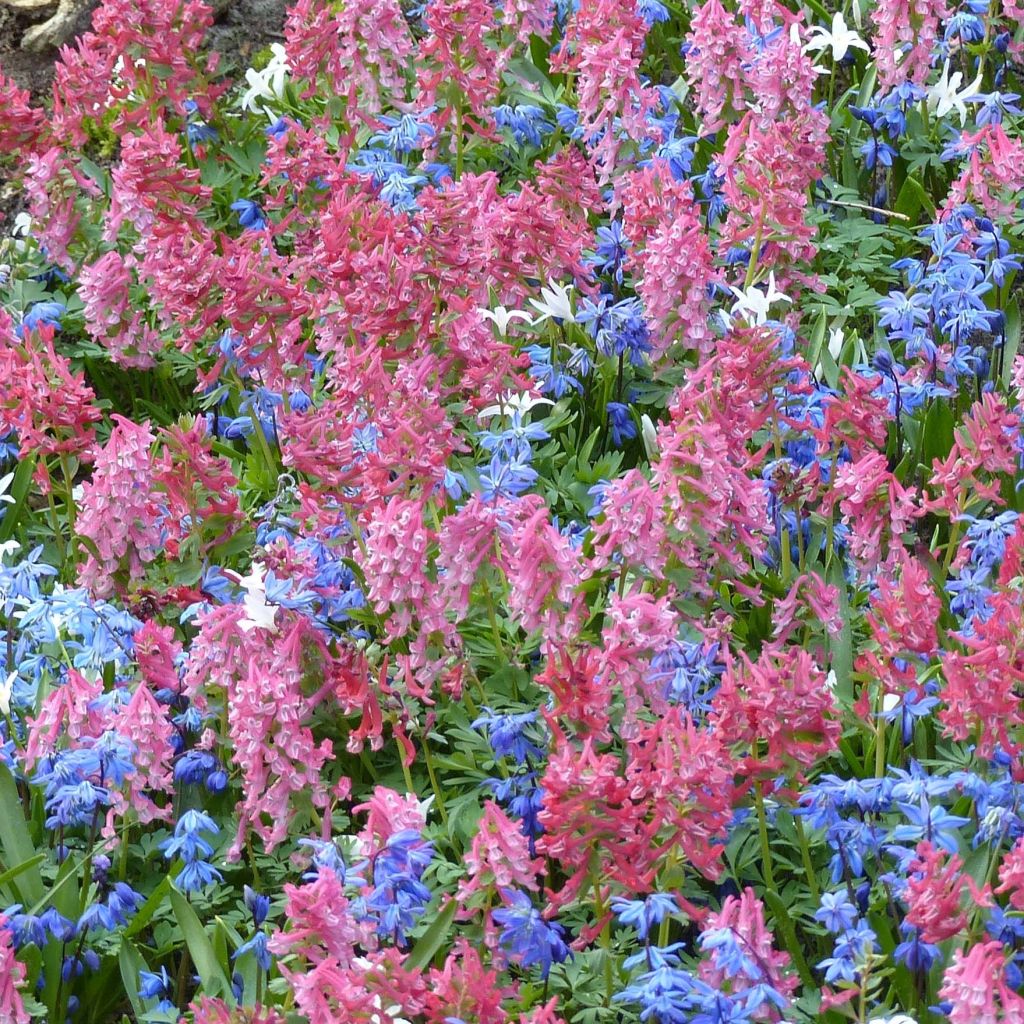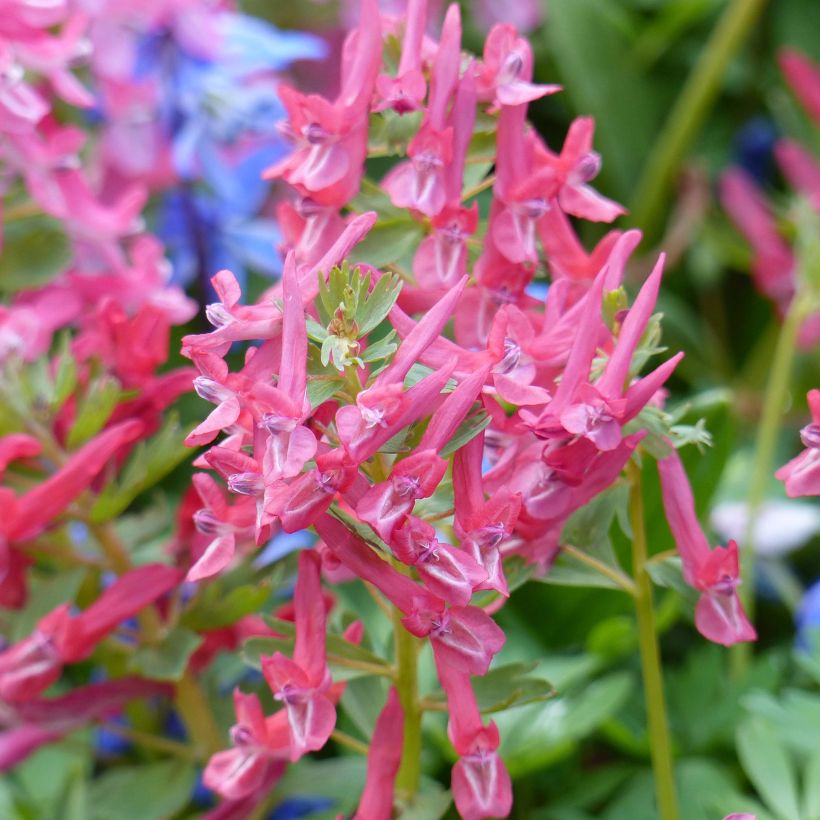

Corydalis solida GP Baker - Corydale bulbeuse


Corydalis solida GP Baker - Corydale bulbeuse
Corydalis solida G.P. Baker
Corydalis solida GP Baker
Fumewort, Solid-rooted fumewort, Bird in a bush
This plant carries a 6 months recovery warranty
More information
We guarantee the quality of our plants for a full growing cycle, and will replace at our expense any plant that fails to recover under normal climatic and planting conditions.
From €5.90 for pickup delivery and €6.90 for home delivery
Express home delivery from €8.90.
Does this plant fit my garden?
Set up your Plantfit profile →
Description
Corydalis solida 'G.P. Baker' stands out with its particularly colourful flowering. It is an adorable perennial bulbous plant that blooms early in spring, sometimes as early as March, and easily naturalises in cool undergrowth. Its clusters of reddish tubular flowers stand above finely cut foliage, which is very decorative in spring. Perfectly hardy and low-maintenance, it disappears from the surface of the soil in summer. It grows easily in shade or partial shade, in light soil that remains moist.
Corydalis solida is a small bulbous plant native to central and southern Europe, as well as northern and western Asia. It grows in shaded meadows, woods, and copse, as well as in mountain and subalpine meadows in limestone soil. It belongs to the Papaveraceae family, just like poppies. The 'G.P. Baker' cultivar is a hardy plant that develops its foliage in spring. Its light grey-green leaves are divided into 3 narrow, cut, and ovate segments. They measure 5 to 8cm (2 to 3in) long. Corydalis solida reaches a height of about 15 to 20cm (6 to 8in) at maturity, with a width of 20 to 25cm (8 to 10in). Flowering takes place in spring, from March to May, in the form of compact and upright clusters composed of numerous red-pink tube-shaped flowers, 1 to 2cm (1in) long. They are terminated by 2 lips open on an almost white throat and equipped with a long, downward-curved, tapering spur. The flowers, facing downwards, are gathered in dense spikes on an upright stem. The flowering is followed by the formation of elongated capsule fruits called siliques. Corydalis solida is hermaphrodite and pollinated by insects. The seeds are dispersed by ants. The foliage disappears in summer.
Corydalis 'G.P. Baker' is primarily a shade or partial shade plant that will reveal its full potential on the edge of undergrowth. It can be planted with other perennials that are not afraid of the competition from tree or shrub roots. Accompany it with Solomon's Seal's cousin (Uvularia grandiflora), hardy fuchsias, purple creeping bugle, Japanese anemones, Balkan Digitalis, Tricyrtis, a carpet of periwinkle, and 'Ivory Heart' bleeding heart. This plant also performs well in pots and creates a beautiful effect in hanging baskets from which it cascades. Plant this corydalis above walls or in shaded rockeries.
Report an error about the product description
Corydalis solida G.P. Baker in pictures


Plant habit
Flowering
Foliage
Botanical data
Corydalis
solida
GP Baker
Fumariaceae - Papaveraceae
Fumewort, Solid-rooted fumewort, Bird in a bush
Cultivar or hybrid
Planting and care
Ideally, plant Corydalis solida in full sun or partial shade, or even in full shade, in very well-drained and moderately fertile soil. It tolerates the presence of limestone and clay in the soil. This young plant prefers soils that remain moist, even in summer, especially if exposed to the sun. It is easily cultivated in most regions. Mildew and rust can develop if the atmosphere or soil is too dry. Aphids and gastropods attack this plant.
Planting period
Intended location
Care
This item has not been reviewed yet - be the first to leave a review about it.
Haven't found what you were looking for?
Hardiness is the lowest winter temperature a plant can endure without suffering serious damage or even dying. However, hardiness is affected by location (a sheltered area, such as a patio), protection (winter cover) and soil type (hardiness is improved by well-drained soil).

Photo Sharing Terms & Conditions
In order to encourage gardeners to interact and share their experiences, Promesse de fleurs offers various media enabling content to be uploaded onto its Site - in particular via the ‘Photo sharing’ module.
The User agrees to refrain from:
- Posting any content that is illegal, prejudicial, insulting, racist, inciteful to hatred, revisionist, contrary to public decency, that infringes on privacy or on the privacy rights of third parties, in particular the publicity rights of persons and goods, intellectual property rights, or the right to privacy.
- Submitting content on behalf of a third party;
- Impersonate the identity of a third party and/or publish any personal information about a third party;
In general, the User undertakes to refrain from any unethical behaviour.
All Content (in particular text, comments, files, images, photos, videos, creative works, etc.), which may be subject to property or intellectual property rights, image or other private rights, shall remain the property of the User, subject to the limited rights granted by the terms of the licence granted by Promesse de fleurs as stated below. Users are at liberty to publish or not to publish such Content on the Site, notably via the ‘Photo Sharing’ facility, and accept that this Content shall be made public and freely accessible, notably on the Internet.
Users further acknowledge, undertake to have ,and guarantee that they hold all necessary rights and permissions to publish such material on the Site, in particular with regard to the legislation in force pertaining to any privacy, property, intellectual property, image, or contractual rights, or rights of any other nature. By publishing such Content on the Site, Users acknowledge accepting full liability as publishers of the Content within the meaning of the law, and grant Promesse de fleurs, free of charge, an inclusive, worldwide licence for the said Content for the entire duration of its publication, including all reproduction, representation, up/downloading, displaying, performing, transmission, and storage rights.
Users also grant permission for their name to be linked to the Content and accept that this link may not always be made available.
By engaging in posting material, Users consent to their Content becoming automatically accessible on the Internet, in particular on other sites and/or blogs and/or web pages of the Promesse de fleurs site, including in particular social pages and the Promesse de fleurs catalogue.
Users may secure the removal of entrusted content free of charge by issuing a simple request via our contact form.
The flowering period indicated on our website applies to countries and regions located in USDA zone 8 (France, the United Kingdom, Ireland, the Netherlands, etc.)
It will vary according to where you live:
- In zones 9 to 10 (Italy, Spain, Greece, etc.), flowering will occur about 2 to 4 weeks earlier.
- In zones 6 to 7 (Germany, Poland, Slovenia, and lower mountainous regions), flowering will be delayed by 2 to 3 weeks.
- In zone 5 (Central Europe, Scandinavia), blooming will be delayed by 3 to 5 weeks.
In temperate climates, pruning of spring-flowering shrubs (forsythia, spireas, etc.) should be done just after flowering.
Pruning of summer-flowering shrubs (Indian Lilac, Perovskia, etc.) can be done in winter or spring.
In cold regions as well as with frost-sensitive plants, avoid pruning too early when severe frosts may still occur.
The planting period indicated on our website applies to countries and regions located in USDA zone 8 (France, United Kingdom, Ireland, Netherlands).
It will vary according to where you live:
- In Mediterranean zones (Marseille, Madrid, Milan, etc.), autumn and winter are the best planting periods.
- In continental zones (Strasbourg, Munich, Vienna, etc.), delay planting by 2 to 3 weeks in spring and bring it forward by 2 to 4 weeks in autumn.
- In mountainous regions (the Alps, Pyrenees, Carpathians, etc.), it is best to plant in late spring (May-June) or late summer (August-September).
The harvesting period indicated on our website applies to countries and regions in USDA zone 8 (France, England, Ireland, the Netherlands).
In colder areas (Scandinavia, Poland, Austria...) fruit and vegetable harvests are likely to be delayed by 3-4 weeks.
In warmer areas (Italy, Spain, Greece, etc.), harvesting will probably take place earlier, depending on weather conditions.
The sowing periods indicated on our website apply to countries and regions within USDA Zone 8 (France, UK, Ireland, Netherlands).
In colder areas (Scandinavia, Poland, Austria...), delay any outdoor sowing by 3-4 weeks, or sow under glass.
In warmer climes (Italy, Spain, Greece, etc.), bring outdoor sowing forward by a few weeks.


































